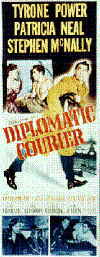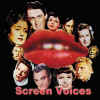Passing the Celluloid Baton
By Stu Kobak
Click thumbnails to enlarge
For movie lovers, sharing is one of the great pleasures. Dissecting the delights of a fine film over coffee or wine, with a cookie thrown in, makes a good movie better and provides an outlet for rage over a bad one. Sharing movies with your children will provide a family forum for years. Passing on a love of films to the next generation is a sacred duty. Though selecting the films to watch together is not always an easy task.
 |
My
father has been gone almost a dozen years, but movies
provided some of out finest moments of communication and
communion. I can still remember that first encounter with a
drive-in theater somewhere in Vermont. Diplomatic Courier was
the flick and Tyrone Power the star. Ironically, that’s one of
the only movies I remember seeing with my father in a theater.
We shared most of our movies on the early TVs! There was Million
Dollar Movie, Picture for a Sunday Afternoon, and the endless
string of CBS movie fare, The Late Show, The Late Late Show,
and—I swear—The Late Late Late Show. Many times I crept out of bed long
after my mother had kissed me good night, and a movie was always
on the TV. My father was an easy con on those nights—I’d
sweetly asked to watch for a few minutes. That’s one thing he
passed on to me; I’ve always been the easy con for my kids
when it comes to sharing movies.
Family viewing and sharing is a much
more complex matter today. The modern home has a TV in every
room. “Family” movie night often means a separate video for
the kids in one room and for the adults, far away, in another.
My parents didn’t have the difficulty contemporary families
have in convincing their children to watch older movies at home.
I voraciously devoured anything presented. Black and white? No
problem. It was all black and white. Classics? Everything seemed
a classic then.
Today, older movies present
obstacles. But you can overcome them through careful selection.
The Wizard Of Oz has worked wonders for both our children. It
has just the right balance of delight and fear, and it has fairy
tale color and a story played out with a vibrant intensity
exceeding anything delivered on film today. Kids just love this
movie. It may be old (1939), but the magic still captures the
imagination.
The color of The Wizard Of Oz can be a
back-door entry to black and white films for your children. Most
kids will vehemently protest—as out of date—anything in
black and white. (Plenty of adults do, too.) A reminder that The
Wizard Of Oz is just as old as the black and white movie
you’re offering can ease the initiation. The Wizard of Oz is
available on DVD, with the latest edition offering up the goodies
from the Ultimate Oz special editon laser disc.
 |
A
modern fairy tale through the eyes of the very original director Tim
Burton, Edward Scissorhands is an interesting choice to
entice younger viewers. Perhaps not an obvious choice given the
skewed point of view of the director, the film captures the magic of
classic fairy tale telling. Burton's derivative satire.
combining classic elements of horror films and a John Waters
sensibility toward society, is awash in exciting colors. Johnny
Depp's monster is thoroughly innocent and childlike and the kids
will instantly identify with him. Caroline Thompson collaborated
with Burton on the story and the screenplay, but Edward can only
come from the imagination of an outsider like Burton. Listening to
Burton's audio commentary on the new special edition DVD of the film
is quite revealing as to the origins of the story and the psyche
behind it. The DVD, while colorful, has many scenes that are too
soft and colors bleed slightly. Overall, this is as good as I have
seen the film. If memory serves, and it isn't always adequate, the
film suffered from the same softness in theaters. Edward makes a
nice pathway to segue into some vintage horror stuff, perhaps Frankenstein
or others of that ilk. Young Frankenstein might be another perfect
choice to overcome the barrier often erected over black and white
films. Once the youngsters cut to the quick in that hilarious film,
resistance to black and white will certainly be reduced.
There are other doors
into black and white, too. The Adventures Of Robin Hood,
directed by Michael
Curtiz, is one of the most colorful
adventure movies ever. For years, I thought the movie was in
black and white, since my introduction was on our old Dumont
black and white TV. What a grand surprise was in store for me!
All the ingredients are splendidly mixed together for perfection
in movie magic. Robin Hood has got screen rake Errol Flynn in
top form, and charming Olivia de Havilland as Lady Marion. The
sword play is exciting and the long-bow work rousing.
The Adventures of Robin Hood is one of
the most sought after DVD titles. With the magnificent three
strip Technicolor and the superb action, this is a core title
for any collection.
Now—after
enchanting them with Robin Hood’s Technicolor cavorting—slip
in the black and white adventure (also starring Flynn and
directed by Curtiz), The Sea Hawk. After a few minutes,
protesting youngsters will fall silent, captivated. The Warner
Brothers team is at its creative peak with this film. Flynn
plays Captain Geoffrey Thorpe, Queen Elizabeth’s favorite
defender of the British seas and the scourge of King Philip’s
Spanish galleons. The Sea Hawk is set at the birth of the famed
Spanish Armada. In this fictionalized account, Thorpe and some
of his fellow privateers suspect England’s ally Spain of
secretly preparing to make war on England. The movie revolves
around Thorpe’s attempt to prove the Spanish treachery.
 |
Director Michael Curtiz takes Thorpe on
the most adventurous route in search of proof. He stages the sea
battles with devil-may-care excitement. The crash of sabers and
the rope-born boarding parties are brilliantly vital. Before
Thorpe succeeds in bringing the truth to England, he does time
as a galley slave and sails the waters of the “New World.”
No small share in the achievement
of The Sea Hawk must go to the silken photography of Sol Polito.
Whether capturing the big master shots of dueling ships at sea
or bringing new dimensions to the art of swordplay, Polito’s
camera is unfailing. The unforgettable climactic duel between
Thorpe and his enemy Wolfingham is splendidly highlighted by
dancing silhouettes.
With The Sea Hawk, Erich Wolfgang Korngold delivers one of the
finest scores ever written for the screen. As in Captain Blood
and The Adventures Of Robin Hood, Korngold embroiders the action
with magnificent music founded on his classical Viennese
training. Flynn is wonderful, alternately dashing and charming,
a nobleman with a touch of rogue. He charms audiences as well as
well as his queen. Flora Robson places her own crest on the role
of Elizabeth. She stands equal to Flynn in their great scenes
together, managing to hint at some roguishness of her own. Henry
Daniell is appropriately odious as Lord Wolfingham and Claude
Raines wears the robes of treachery with smarmy ease. Alan Hale
is a hearty Mr. Pitt, once again playing sidekick to Flynn as he
did as Little John in The Adventures Of Robin Hood.
The Sea Hawk is not yet
available on DVD, but hopefully Warner will release the
marvelous adventure before very long.
An hilarious spoof of the
epic swashbuckler genre, The Court Jester is probably the best
of all Danny Kaye’s daffy films. This time Kaye finds himself
in merry old England playing Hawkins, a look-alike of the Fox, a
character modeled after Robin Hood. Kaye assumes the identity of
Giacomo, a court jester and assassin en route to the English
court. I can’t imagine fitting Danny Kaye into a more
appropriate costume. The result is an assault of laughter.
The writing/directing team of Norman
Panama and Melvin Frank could do no wrong. The plot is well
constructed and the dialog uproarious. The clever couplets of
The Court Jester remain with lovers of the film forever. A
dialog sequence as simple as “Get it?” “Got it.”
“Good.” is delicious in repetition. “The pellet with the
poison’s in the vessel with the pestle; the chalice with the
palace has the brew that it true” is mangled with brilliant
aplomb by Kaye. His double-talk never integrated so well as it
does here. And the sight of Kaye approaching the royal person
before his duel with Sir Griswold doubles me over in laughter
every time.
Even
the musical numbers are in perfect harmony with the plot, and
Kaye is ably abetted in the hilarity by a cast of seasoned pros.
Basil Rathbone brings dour sincerity to the role of Ravenswood,
power behind the English throne—a role clearly modeled after
Rathbone’s earlier Sir Guy of Gisborne in The Adventures Of
Robin Hood. Playing straight-man to Kaye, Rathbone never cracks
a hint of smile. Mildred Natwick is wonderful as the sorceress
Griselda who hypnotizes Kaye into doing dirty deeds. And Glynis
Johns is charming as the love interest.
The
Court Jester was filmed in Paramount’s VistaVision process,
meant to project ideally at an 1.85:1 aspect ratio. The color on
The Court Jester is absolutely invigorating. What a great
high. All the richly adorned costumes of the king's court come
to life on this DVD. The high energy of the production is
enhanced by the visual beauty of this wonderful film. Though
high color saturation can lead to color bleeding, The Court
Jester maintains it's color integrity throughout. The
picture is quite sharp. There is slight edge enhancement, but
it's not disturbing. God bless Paramount for taking the trouble
to make this grand entertainment an anamorphic transfer. I'm
plain greedy. I want The Court Jester to look as good as
it can since it's one of my all time favorite movies, and this
is probably as good as it will ever look. There are several
scenes in which there was stationary dirt on the Rank which
shows up prominently against the blue skies. Too bad. The sound
is just fine. It's clean, the glorious lyrics and clever
dialogue are easy to understand. Could you ask for anything
more?
Good
family viewing consists of more than just adventure, of course.
We can explore with our children very serious subjects through
films. One Rosh Hashanah, my wife and I chose to share The
Diary Of Anne Frank with our then eight-year-old Lizzie, remembering,
together, a Jewish family in circumstances very different from
the plush surroundings of our home theater.
Anne Frank was cooped up in a Holland attic for more than two
years with her family of four, another family of three, and an
eighth fugitive, a dentist. They were hiding from the Nazis and
the confinement they endured was far better than the fate that
ultimately awaited them. Only Anne’s father survived.
By
nature, the set of Diary is stage-bound, which effectively
emphasizes the tensions endured by families forced to silently
share tight quarters. Through his gifted sense of timing,
veteran director George Stevens prevents his audience from
growing bored of the claustrophobic attic.
 |
Anne
Frank’s story is an inspiring record of human decency, not
only from the point of view of the Frank family and their fellow
fugitives, but from the deadly risk taken by the shopkeepers who
sheltered them. George Stevens proves a wise choice as director.
Fifty years ago, Stevens was one of the Army photographers who
recorded the liberation of the Nazi concentration camps,
capturing the reality of the horror in the starkest of images.
Those haunting moments must have endowed Stevens with a unique
sensibility in directing his actors.
Millie
Perkins plays Anne Frank in a straightforward, undistinguished
manner. Perkins never shares with the audience what might be
going on the inside this young woman, who entered her
confinement at the age of 13, just beginning to explore the
feelings of womanhood. Joseph Schildkraut is a powerful center
of reason for the attic’s occupants and Shelley Winters, who
won an Academy Award as Best Supporting Actress for Mrs. Van
Daan, creates a consistently interesting character. Richard
Beymer, playing the Van Daan son, is a constant surprise,
displaying fine sensitivity in his scenes with Perkins. Douglas
Spencer and Dody Heath as Kraler and Miep, the shop owners who
shelter the refugees in their attic, are both wonderful.
Spencer, a savvy character actor, has his finest screen moments
under Stevens’ direction, and Ed Wynn playing dentist Albert
Dussell is both irritating and moving.
Presented
in its original widescreen Cinemascope aspect ratio of 2.35:1, Fox Video
released a laserdisc several years ago that exquisitely captures the nuances of the
Academy Award winning (black and white) photography of William
C. Mellor. Hey, Fox, when can we expect a spectacular DVD for
this title?
By
digging into the classic film repertory, your choice of films
for family sharing becomes endless. After a time, you’ll
probably find that the kids will almost always want to watch
together as a family. I wouldn’t start off with a film as
talky and static as The Diary Of Anne Frank, but once you have
lured your children into the world of cinema, it becomes easier
to broaden their horizons. The secret is the art of the
seduction. From Errol Flynn and Danny Kaye to Anne Frank and
even to Tim Burton, we owe
our children the joy of these great screen treasures. And in
sharing them, we add another layer of pleasure to our own film
memories.
Click thumbnails to enlarge
![]()
The Feature
Archive has articles ranging from John
Ford to Blonde
Bimbos, The
Heistmasters, Akira
Kurosawa and Frank
Darabont and Vietnam.

Click on the image above to learn more about the effect of
an actor's voice on his screen persona.
The Movie Poster Archive include extensive poster images from the films of stars like Susan Hayward, Kirk Douglas, Katharine Hepburn and many more. Our featured star is Spencer Tracy.
DVD Deals may be the best site for all you high-tech bargain hunters. This site helps you find coupons and cheap dvds at all the major online stores.
![]()
DVD links, information about Web specials, news, Site reviews.
![]()
News, information, features about
current films in theaters and in the pipeline. Easy to use
interface.
![]()
Excellent resource for movie review
links, with many early looks.

The National Film
Preservation Foundation (NFPF)
is the nonprofit organization created by the U.S. Congress to save
America's film heritage.
![]()
A great place for movie lovers and
techies to visit for exchange of ideas. New speedy interface is an
inspiration for more dialogue.

This Canadian online DVD retailer
may not offer pepperoni, but does have a selection of 5000 plus
DVDs. How about deep-dish discounts guys.
![]()
![]()
The Big Combo
has style to spare in reviewing films and producing feature
articles. Check out their special "Lingo" section.
 Brad
Lang continues to add more interesting to the extensive collection
at Classic
Movies. Everything from actors and actress to
your favorite directors is linked at the site.
Brad
Lang continues to add more interesting to the extensive collection
at Classic
Movies. Everything from actors and actress to
your favorite directors is linked at the site.

The Cinema Laser
A home grown magazine for laserphiles that has been publishing for a number of years and has embraced DVD in a big way. Lots of helpful information.
Imaging Science Foundation

The Imaging Science Foundation promotes proper standards in home theater viewing. ISF trained technicians offer monitor calibration services to consumers. The difference in a properly calibrated monitor can be astounding. Click on the image to find an ISF member near you.
![]()
A hallmark of Film Threat Magazine is irreverence. The transition
from print to the Internet leaves the acid base in tact. Humorous
criticism with a vengeance.
![]()
Cinemedia
is the largest film and media directory with over 25,000
links.
Click on
the DVD MIA symbol for profiles of DVDs missing in action.
Add films to the DVD
MIA Master List by
filling out a simple form. Click
Here
Need a daily fix of movie quotes. Reel Quotes Newsletter has the answer. Click on the Reel Quotes symbol for more.